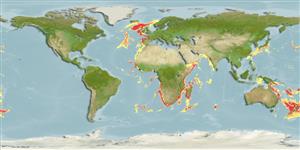Élasmobranches (requins et raies) (sharks and rays) >
Squaliformes (Bramble, sleeper and dogfish sharks) >
Centrophoridae (Gulper sharks)
Etymology: Centrophorus: Greek, kentron = sting + Greek, pherein = to carry (Ref. 45335).
Environnement / Climat / Gamme
Écologie
; marin bathydémersal; profondeur 145 - 2400 m (Ref. 6871). Deep-water, preferred 23°C (Ref. 107945); 69°N - 54°S, 92°W - 176°W
North-western Atlantic, north-eastern and south-eastern Atlantic. Western and eastern Indian Ocean. South-western Pacific, north-western Pacific, and south-eastern Pacific.
Length at first maturity / Taille / Poids / Âge
Maturity: Lm 124.5, range 110 - 158 cm
Max length : 164 cm TL mâle / non sexé; (Ref. 58048)
Épines dorsales (Total): 2; Rayons mous dorsaux (Total): 0; Épines anales 0; Rayons mous anaux: 0. A large gulper shark with a short, broad snout, a long, low 1st dorsal fin, short pectoral rear tips, and large, rough, leaf-like denticles (Ref. 5578). Dark grey or chocolate brown in color (Ref. 5578).
Found on or near the bottom of continental slopes; also found pelagically in the upper 1,250 m of water 4,000 m deep (Ref. 31367). Presumably feeds on fish and cephalopods (Ref. 6871). Ovoviviparous (Ref. 50449). Utilized and fishmeal and dried salted for human consumption (Ref. 247); meat and fins (low value) and liver oil (very high value), and occasionally for its mature eggs (Ref.58048).
Ovoviviparous, embryos feed solely on yolk (Ref. 50449). Young numbers 5-8 in a litter (Ref. 6871). Size at birth 35-43 cm (Ref. 26346). Distinct pairing with embrace (Ref. 205).
Compagno, L.J.V., 1984. FAO Species Catalogue. Vol. 4. Sharks of the world. An annotated and illustrated catalogue of shark species known to date. Part 1 - Hexanchiformes to Lamniformes. FAO Fish. Synop. 125(4/1):1-249. Rome, FAO. (Ref. 247)
Statut dans la liste rouge de l'IUCN (Ref. 115185)
CITES (Ref. 94142)
Not Evaluated
Menace pour l'homme
Harmless
Utilisations par l'homme
Pêcheries: intérêt commercial mineur
Plus d'informations
RéférencesAquacultureProfil d'aquacultureSouchesGénétiqueFréquences alléliquesHéritabilitéPathologiesTraitementMass conversion
CollaborateursImagesStamps, CoinsSonsCiguateraVitesseType de nageSurface branchialeOtolithesCerveauxVision
Outils
Articles particuliers
Télécharger en XML
Sources Internet
Estimates of some properties based on models
Phylogenetic diversity index (Ref.
82805): PD
50 = 0.5003 [Uniqueness, from 0.5 = low to 2.0 = high].
Bayesian length-weight: a=0.00263 (0.00156 - 0.00444), b=3.18 (3.03 - 3.33), in cm Total Length, based on LWR estimates for this species & (Sub)family-body (Ref.
93245).
Niveau trophique (Ref.
69278): 4.5 ±0.3 se; Based on diet studies.
Résilience (Ref.
69278): Faible, temps minimum de doublement de population : 4,5 à 14 années (tmax=71; K=0.04-0.05; Fec=5-8).
Vulnérabilité (Ref.
59153): Very high vulnerability (86 of 100) .
